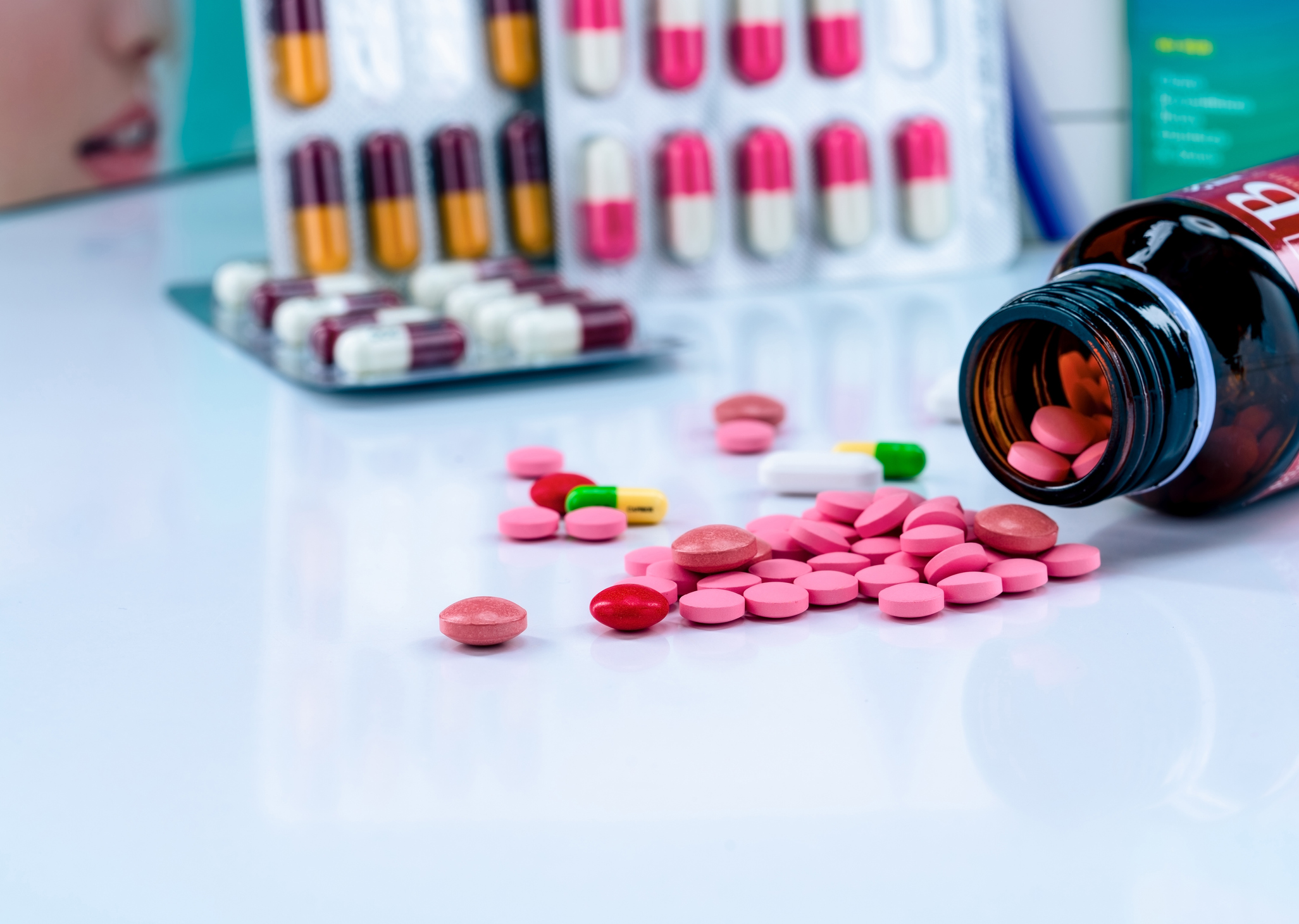- ema.europa.eu - Antimicrobial resistance
- ema.europa.eu - EU Antibiotic Awareness day infocards 2020
- ema.europa.eu - Guideline on legal status for the supply to the patient of centrally authorised medicinal products
- ncbi.nlm.nih.gov - Antimicrobials, Pauline Hood, Ehsan Khan, Florence Nightingale
- eurosurveillance.org - Analysis of licensed over-the-counter (OTC) antibiotics in the European Union and Norway, 2012, L. Both, R. Botgros, M. Cavaleri
- mayoclinicproceedings.org - General Principles of Antimicrobial Therapy, Surbhi Leekha, MBBS; Christine L. Terrell, MD; Randall S. Edson, MD
- solen.sk - Antibiotic therapy, Václava Adámková, MD
Antibiotics without a prescription - can we find them in the pharmacy?

Antibiotics are one of the most widely used drugs not only in this country but also in the world. Are they available in pharmacies without a prescription? What are the risks of their misuse and why is bacterial resistance to antibiotics becoming a growing problem worldwide?
Article content
Antibiotics are an important and currently the most widely used group of drugs we have in medicine.
They are used to treat infectious diseases that are caused by bacteria. The mechanism of action of antibiotics is to kill bacteria (bactericidal effect) or to slow and stop their growth and multiplication (bacteriostatic effect).
They belong to the group of anti-infective drugs, in which various other types of drugs are also represented. In addition to antibiotics, we also include drugs:
- for the treatment of infections caused by viruses - antivirals
- for the treatment of infections caused by fungi, moulds or yeasts - antifungals
- for the treatment of infections caused by parasites - antiparasitics
The most common bacterial infections for which antibiotics are used are acne, bacterial bronchitis and upper respiratory tract infections, conjunctivitis, otitis media, sexually transmitted infections, urinary tract infections, inflammation of the skin and soft tissues or streptococcal throat infections.
Tabular overview of antibiotic groups and examples of antibiotics according to their effect on bacteria
| Bactericidal antibiotics | Bacteriostatic antibiotics | ||
| Penicillins | Amoxicillin Ampicillin Oxacillin | Macrolides | Erythromycin Spiramycin Azithromycin |
| Kephalosporins | Cephalexin Cefuroxime Ceftriaxone | Tetracyclines | Doxycycline Tetracycline Minocycline |
| Monobactams | Aztreonam Carumonam | Amphenicol | Chloramphenicol Tiamphenicol |
| Carbapenems | Meropenem Ertapenem Imipenem | Sulfonamides | Sulfanilamide Sulfadiazine Sulfathiazole |
| Aminoglycosides | Streptomycin Tobramycin Gentamicin | Lincosides | Clindamycin Lincomycin |
| Quinolones | Ofloxacin Ciprofloxacin Pefloxacin | Trimethoprim | |
| Glycopeptides | Vancomycin Telavancin | ||
| Imidazole derivatives | Metronidazole Tinidazole Ornidazole | ||
| Polymyxins | Colistin Polymyxin B | ||
Depending on the origin, several types of antibiotics are distinguished.
- Drugs isolated from living organisms are substances produced by certain fungi or bacteria.
- Drugs prepared synthetically.
- Polysynthetic drugs have a natural basis, but their structure has been synthetically altered in some way.
In terms of the spectrum of action of antibiotics, i.e. whether they are effective against only one particular group of bacteria or against several types simultaneously, antibiotics are divided into two groups.
The first group is narrow-spectrum antibiotics, which allow targeted treatment of usually one group of bacteria. This includes, for example, targeted treatment of staphylococci, bacteria causing tuberculosis, etc.
The second group are broad-spectrum antibiotics, which act simultaneously on several groups of bacteria, e.g. Gram-positive, Gram-negative bacteria, etc.

Microorganisms in the human body
Microorganisms are a natural part of the world around us. They are even present in us.
Some microorganisms may pose a risk to our health, but for most of them, humans are not their primary target and they do not attack humans.
It is believed that there are currently more than 4-6 x 1030 different species of microorganisms.
The human body is home to many species and types of microorganisms. In the vast majority of cases, their presence is beneficial to humans and they do not cause any health complications.
Some parts of the body are characterised by the presence of relatively large numbers of foreign organisms. A typical example is the intestinal tract, where the presence of bacteria plays an important role in the prevention and defence against pathogenic entities.
However, for some organs and parts of the body the rule of absolute sterility applies. These include most internal organs, bones, blood and the central nervous system.
The penetration of microorganisms into sterile parts of the body automatically means the development of infection.
Antibiotic treatment - what are its rules?
When treating bacterial infections with antibiotics, several basic rules apply.
1.
The aim of antibiotic treatment is to kill or suppress the bacteria, i.e. to stop their growth and multiplication and thus the spread of infection in the host organism.
At the same time, the host organism should not be harmed in any way as a result of the treatment. We speak of the selective effect of the antibiotic.
In order to achieve a selective effect for antibiotics, it is necessary to identify an element in the bacterium and its structure or metabolism that clearly distinguishes it from the host.
Consequently, the effect of the antibiotic targets this difference and the organism's own cells are not damaged in this way.
In bacteria, the distinguishing feature is identified as, for example, their shape, Gram-positive or Gram-negative nature, susceptibility, cell membrane, different size of ribosomes, etc.
In practice, however, it is sometimes very difficult to detect individual differences in bacteria. This reduces the selectivity of antibiotics and increases the risk of side effects and toxicity to the host.
2. Selection of the appropriate antibiotic
One of the key steps in the treatment of bacterial infections is the selection of an appropriate treatment regimen and the right drug.
This is a complex process in which the physician in deciding the correct treatment:
- uses his or her practical experience
- takes into account the patient's test results
- individually assesses the benefit/risk ratio of the treatment
- tries to avoid overuse of antibiotics
- takes into account the possibility of resistance and reduced effectiveness of the antibiotic in the future
At the same time, the physician should follow several principles when determining the appropriate treatment:
- prescribe the antibiotic for the shortest possible period of time
- at the most appropriate dose
- and use the most appropriate route of administration
The effectiveness of an antibiotic against a given bacterium is judged on the basis of the minimum inhibitory concentration (MIC). This is the lowest concentration of the drug that is able to inhibit the growth and multiplication of the bacterium.
It distinguishes bacteria as sensitive (MIC is equal to or lower than the total drug concentration), moderately resistant and resistant (MIC is higher than the total drug concentration).

3. Correct dosage form
To properly target an infection that has developed in the body, it is important to select a drug that will be able to reach the site of infection in the desired amount or concentration.
Most antibiotics are given orally (by mouth) or intravenously (into a vein). In these cases, the penetration of the drug into the blood is direct or almost direct. The active substance is then transported by the blood to the sites where it is needed.
In cases where there is little or no blood supply to the part of the body affected by the infection, delivery of the drug may be problematic. An example is the cornea of the eye.
In this case, instead of the above mentioned dosage forms, other forms such as eye drops are used for topical application.
4. Dosage of the medicinal product
The action of antibiotics and their effectiveness depends on two basic factors.
The first is concentration. We are talking about concentration-dependent antibiotics.
With these drugs, it is not the number of doses taken that is decisive, but the degree of concentration achieved. Therefore, they are given less frequently and in larger doses (these are usually once-daily antibiotics).
The second factor determining the effect of antibiotics is time. We are talking about time-dependent antibiotics. The important parameter is not the maximum dose but the duration of action at the site of infection.
These antibiotics are given in smaller doses but more frequently (several times a day).
A typical example of a concentration-dependent antibiotic is gentamicin and a time-dependent antibiotic is penicillin.
5. Side effects
As with other drugs, there is a risk of side effects with antibiotic treatment.
If antibiotics are used at the right time, at the right dose and only when indicated, the incidence of adverse effects can be reduced.
Allergic reactions and digestive problems are among the most common side effects of almost all types of antibiotics.
Allergic reactions arising from the use of antibiotics may be seen as minor skin reactions such as rash and itching of the skin.
In more severe cases, they can develop into blisters on the skin, swelling of mucous membranes and some parts of the body. Swelling of the face and throat in conjunction with respiratory problems can be life-threatening.
Digestive problems are caused by antibiotics, which can attack the so-called good bacteria in the digestive tract in addition to the target bacteria (this is especially true for broad-spectrum antibiotics).
By upsetting the intestinal balance, the bacteria multiply and cause digestive problems, most commonly diarrhoea and abdominal pain.
The appropriate regimen for antibiotic treatment is the concomitant use of probiotics, which restore the composition of the intestinal microflora and thus bring it back into balance. Probiotics should not be taken at the same time as antibiotics. They should be given at least 2-3 hours apart.
When should antibiotics not be taken?
Not every infection requires treatment with antibiotics. Antibiotics are used to treat bacterial infections.
However, other microorganisms, such as viruses, can also cause infections. These most commonly cause throat infections, colds, flu, bronchitis or sinus infections.
In this case, the use of antibiotics is inappropriate because:
- They are unable to target and kill the virus.
- They will not help cure your illness or improve your health.
- They can cause side effects.
- Their unnecessary use can lead to dangerous resistance.
A simple way to distinguish the causative agent of an infection (virus or bacteria) and to determine the correct treatment is the CRP test. It measures the C-reactive protein in the blood, which is produced by the body. Its level increases significantly in the case of a bacterial infection. The test is quick, reliable and is also used to check whether the infection goes away after treatment with antibiotics.

Have you ever encountered a situation where your doctor prescribed antibiotics for a viral illness?
In some cases, this situation also occurs.
This is probably due to non-adherence or lack of effect of regimen measures such as rest, adequate rest and fluids or symptomatic treatment, which are crucial in the treatment of viral diseases.
If your doctor suspects that you are at risk of worsening your condition and possible complications, he or she may prescribe antibiotics. They prevent associated bacterial infections that are caused by weakening the body with an existing infection.
What do we mean by bacterial resistance?
Resistance of bacteria to the action of antibiotics, otherwise known as bacterial resistance, is a condition in which the bacteria is able to resist the effects of antibiotics.
In practice, there are two types of resistance - intrinsic and acquired.
Intrinsic bacterial resistance means that a bacterium is naturally resistant to the action of an antibiotic due to one of its characteristics.
A simple example of such a property is the outer membrane of the bacterium (in Gram-negative bacteria) and its impermeability to certain antibiotic molecules.
The second and more dangerous type of resistance is acquired resistance. The name implies that the bacterium acquired this ability during its evolution.
We speak of acquired resistance when a bacterium becomes more resistant or completely resistant to the action of antibiotics that were originally harmful to it.
The antibiotic then loses its effect or its effect on the bacterium is significantly reduced.
Acquired resistance develops naturally in bacteria. One possibility is a genetic mutation in the bacterium. This causes a change in the original target structure that was targeted by the antibiotic.
Another way is to acquire a resistance gene, which the bacteria spread among themselves or acquire from the environment.
In this way, a bacterium may become resistant to only one group of antibiotics or, in a worse case, to several groups of antibiotics, in which case we speak of multidrug resistance.
An example of a bacterium resistant to multiple types of antibiotics is Staphylococcus aureus.
The origin of the antibiotic, i.e. whether it is a synthetic drug or the product of a micro-organism, has an impact on the development of resistance. For example, a bacterium producing a substance with antibacterial activity must be resistant to that substance or it will kill it.
Resistance in bacteria arises naturally. It's normal and more or less expected.
But the problem is that it develops much faster than is appropriate and safe. We humans facilitate it by overusing or misusing antibiotics. This accelerates the development of resistance and its spread.
Excessive or inappropriate use of antibiotics gives the bacteria a chance to adapt.
Bacterial resistance affects both humans and animals. It can also be transmitted from animals to humans, either through contact with food or direct contact.
Bacterial resistance as a health threat
Bacterial resistance to antibiotics is currently one of the biggest health threats with a global dimension and a rapid increase.
Infections caused by multidrug-resistant strains of bacteria are responsible for 25 000 deaths per year in Europe.
It is also a threat in terms of a huge burden on the healthcare system. The annual cost of spending on the treatment of bacterial infections in Europe is estimated at around EUR 1.5 billion.
And thirdly, it is a threat to society because of the loss of productivity.
The lack of new antibiotics coming onto the market is exacerbating the problem of growing resistance.

We can briefly summarise the main consequences of bacterial resistance to antibiotics:
- The growth and reproduction of bacteria is not killed or sufficiently suppressed.
- The infection remains in the body, can spread further and cause more serious complications and diseases.
- Treatment options are severely limited as the choice of appropriate and effective antibiotics narrows.
- The use of ineffective antibiotics increases the risk of side effects.
- The patient does not benefit from treatment.
- Treatment is prolonged and hospital admissions increase.
- The cost of treating patients increases.
- The number of deaths increases.
One solution to the problem of bacterial resistance is awareness, education and a responsible approach to antibiotic treatment.
Everyone can start with this.
What is important to understand and what principles should we follow in relation to antibiotics?
- Only take antibiotics if your doctor recommends or prescribes them.
- Take only the prescribed dose of the antibiotic and strictly observe the duration of use.
- Always complete the full prescribed course of treatment. Do not discontinue treatment prematurely, even if the symptoms of the disease have subsided and your condition has improved.
- Do not save unused antibiotics for later in case of the same or a different infection. These antibiotics may not be suitable for the treatment of another infectious disease.
- Do not use antibiotics to treat viral illnesses such as flu or colds.
- Ask your doctor or pharmacist about the possible risks of taking antibiotics.
- Never give an antibiotic that has been prescribed for you to another person to take, even if they have the same symptoms as you. This is also true in reverse.
- By using antibiotics responsibly, you can protect people who are more susceptible to infections (pregnant women, newborns, the elderly, immunocompromised people, people who have had a transplant or have cancer).
- Follow hygiene guidelines to prevent the onset and spread of infection.
Why are antibiotics not over-the-counter?
There are currently no over-the-counter antibiotics available on the market for systemic use.
This is precisely because there are many risks associated with the use of antibiotics and the patient would not be able to assess these risks independently.
Over-the-counter medicines put the patient in the role of a self-medicator, where he/she decides on his/her own health condition and the solution to the health problem, possibly in collaboration with a pharmacist.
In general, when a medicine is available without a prescription, its availability to a larger number of people increases.
A medicine can only be dispensed without the need for a prescription if its safety profile is appropriate and the risk of misuse is very low.
Over-the-counter medicines also save health insurers' costs. The patient pays for them himself and they can be advertised.
Conversely, when must a medicinal product be subject to a prescription or what are the criteria for classifying a medicinal product as a prescription-only medicine?
A medicinal product is classified as a prescription-only medicinal product if it meets any of the above criteria:
- If there is a direct or indirect health risk arising from the use of the medicinal product, even if it is used correctly.
- If the medicinal product is frequently and extensively misused and, as a result, presents a direct or indirect health risk.
- If the medicinal product is available in a dosage form that requires supervision or intervention by a healthcare professional, e.g. parenteral dosage forms.
- If it is a medicinal product for which treatment must be supervised by a physician.
- If the medicinal product is subject to further safety and efficacy monitoring.
- If it is a new medicinal product with which there is not yet sufficient experience.
- If it is a medicinal product that may cause tolerance, dependence or risk of abuse.
- If the medicinal product contains a radioactive component.
A significant majority of antibiotics are classified as prescription medicines, primarily because of the risk of bacterial resistance.
In theory, the availability of over-the-counter antibiotics would make access to them easier and faster. This could be effective in treating infections that usually arise suddenly.
Early intervention would potentially shorten the duration of illness, thereby reducing the incidence of symptoms and the rate of contagion compared to the longer process of visiting a doctor.
However, given the reality of rapidly spreading bacterial resistance, the availability of over-the-counter antibiotics is more of a concern, for example, because of their potential overuse or misuse, or in an effort to maintain the maximum functionality and effectiveness of current treatment regimens.
At the same time, the fact that there is still a lack of new therapeutic options to replace no longer effective treatments for bacterial infections contributes to the concern.
In addition to the systemic effect, i.e. the intrinsic effect that occurs after the drug is absorbed into the blood, antibiotics are also used for their local effect.
In the case of topically administered antibiotics, the risk of systemic side effects is lower and overuse or misuse is more unlikely. This is also why some topical antibiotics have been approved by national authorities as over-the-counter medicines.
These include ointments, creams or solutions, nasal or oral aerosols, eye drops or ointments, or topical lozenges.
Interesting resources
Related










